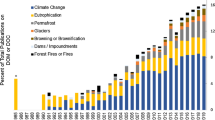Abstract
The chemistry of lakes in the Mt. Zirkel Wilderness Area (MZWA) and the Weminuche Wilderness Area (WWA) of Colorado has been monitored since 1985. The initial results indicate that changes have occurred in the chemistry of some lakes in both areas. Increased concentration of sulfate in lakes may be related to increased atmospheric depositon of sulfate or to changes of sulfate released by weathering and to changing dilution of sulfate by snowmelt. Stable S isotopes seem to be capable of separating the fraction of change in sulfate that is related to atmospheric and watershed sources. Because of the short period of record, it is not possible to determine whether the changes are part of a long-term trend or are merely natural fluctuations about some baseline.
Similar content being viewed by others
References
Caron, F. and Tessier, A.: 1986, Applied Geochemistry 1, 601.
Fishman, M.J. and Friedman, L.C., eds.: 1989, Methods for determination of inorganic substances in water and fluvial sediments: U.S. Geological Survey Techniques of Water Resources Investigations, Book 5, Chapter A1.
Holt, B.D., Engelkemeir, A.G. and Venters, A.: 1972, Environ. Sci. Technol. 6, 338.
Johannessen, M. and Henriksen, A.: 1978, Water Resour. Res. 14, 615.
Nriagu, J.O. and Coker, R.D.: 1978, Tellus 30, 365.
Nriagu, J.O., Coker, R.D. and Barrie, L.A.: 1991, Nature 349, 142.
Snyder, G.L.: 1980a, Geologic map of the central part of the Northern Park Range, Jackson and Routt counties, Colorado: U.S. Geological Survey Miscellaneous Investigations Series Map I-1112, scale 1∶48,000.
Snyder, G.L.: 1980b, Geologic map of the northernmost Park Range and southernmost Sierra Madre, Jackson and Routt counties, Colorado: U.S. Geological Survey Miscellaneous Investigations Series Map I-1113, scale 1∶48,000.
Steven, T.A., Lipman, P.W., Hail, W.J., Jr., Barker, Fred and Luedke, R.G.: 1974, Geologic map of the Durango Quadrangle, southwestern Colorado: U.S. Geological Survey Miscellaneous Investigations Series Map I-764, scale 1∶250,000.
Turk, J.T.: 1988, Use of regional lake-sulfate concentration in the evaluation of watershed processes in high-elevation parts of the Western United States: Verh. Internat. Verein. Limnol. 23, 138.
Turk, J.T. and Campbell, D.H.: 1987, Water Resour. Res., 23, 1757.
Turk, J.T. and Spahr, N.E.: 1991, Controls on the chemistry of Rocky Mountain lakes, p. 471 in Acidic Deposition and Aquatic Ecosystems: Regional Case Studies, D. Charles ed.: Springer-Verlag, New York.
USEPA: 1991, Data User's Guide to the USEPA Long-Term Monitoring Project: Quality Assurance Plan and Data Dictionary, EPA/600/3-91/072.
Van Stempvoort, D.R., Reardon, E.J. and Fritz, P.: 1990, Geochim. Cosmochim. Acta 54, 2817.
Author information
Authors and Affiliations
Rights and permissions
About this article
Cite this article
Turk, J.T., Campbell, D.H. & Spahr, N.E. Use of chemistry and stable sulfur isotopes to determine sources of trends in sulfate of Colorado lakes. Water Air Soil Pollut 67, 415–431 (1993). https://doi.org/10.1007/BF00478156
Received:
Revised:
Issue Date:
DOI: https://doi.org/10.1007/BF00478156




